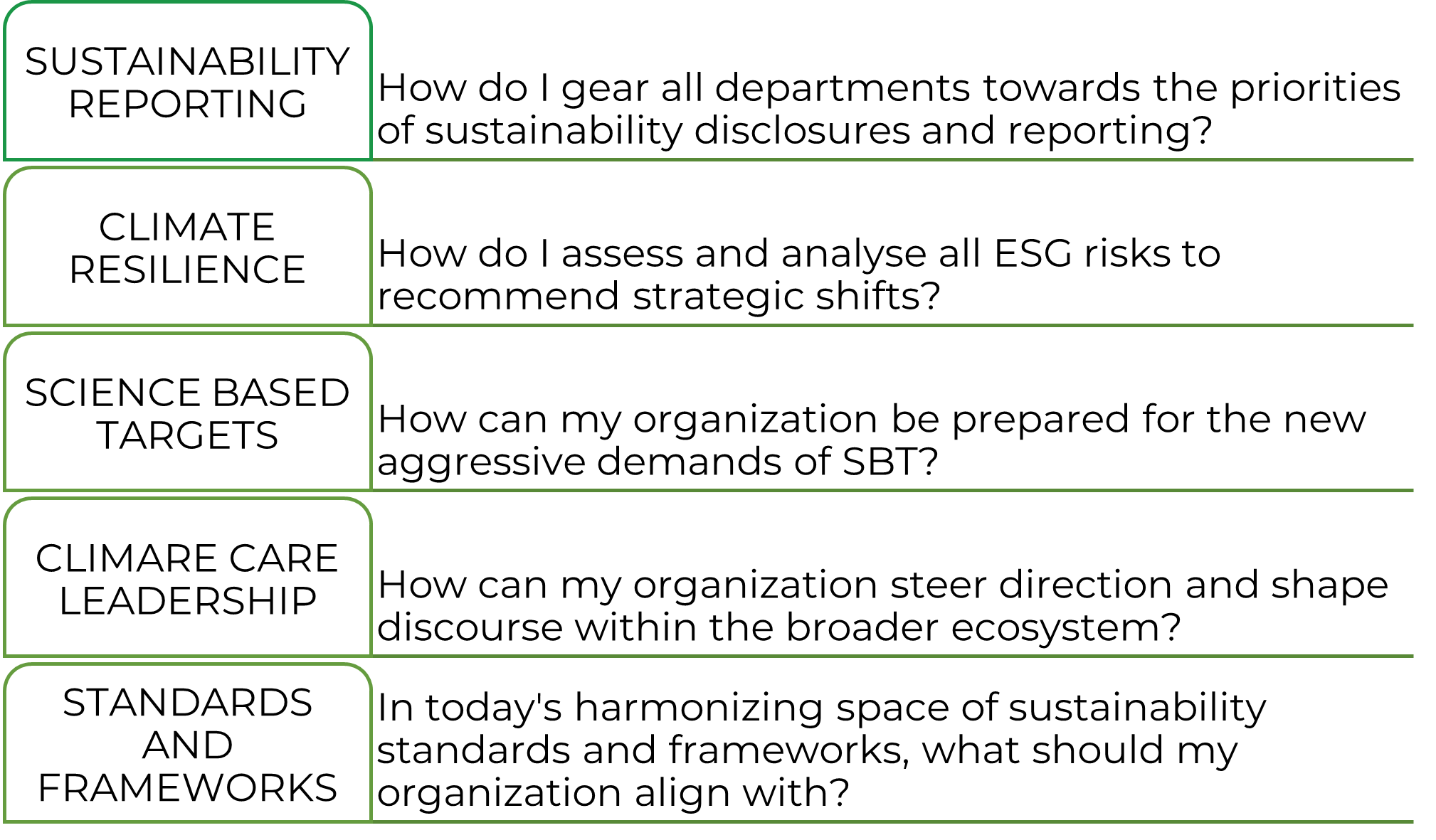
Any organization’s outlook on sustainability can be determined based on the importance they lend to sustainability conversations in the boardrooms. For such conversations to have enough credence, mature organizations have created the C-suite position of the CSO (Chief Sustainability Officer), whose primary mandate is corporate sustainability. This ensures undivided attention to the subject, while ensuring that sustainability stays on top of the strategic agenda too.
The CSO’s office is responsible to steer the dialogue on sustainability across the various departments within the organization. It is also expected that the CSO and his/her team stay on top of the ever-evolving facets of sustainability relevant to the organization. These twin expectations are highly challenging to meet in the real environment. This blog explores the questions that top the CSO’s agenda today.

1. How do I gear all departments towards the priorities of sustainability disclosures and reporting?
Sustainability reporting is becoming highly relevant for the private sector – both due to regulatory demands and voluntary disclosures. For these reports, capturing the true sense of the sustainability relevant across E, S and G dimensions and reporting them appropriately is key. In India, the BRSR template requires significant quantitative information alongside qualitative information. Reporting through the BRSR requires significant rigour across the organization in capturing data from the operations. Each department and the individuals working in them needs to be sensitized to this need.
To begin with, we need to acknowledge that this is not a one-time action. We propose to begin with a thorough analysis of the recently conducted materiality assessment to ensure you have a pulse of your stakeholders. Further, we suggest that you draw your plan to build a sustainability culture across your team, to ensure that they understand the essence of their role in driving sustainability. In the process, we suggest that a custom-built KPI matrix is derived to tie individual performance with that of the corporate sustainability initiatives. For example, employee incentives can be tied to how they contribute towards the lowering of their department’s footprint during daily operations. It is equally important to sensitize the individuals towards this renewed outlook. Further, it is important to capture data points that uplink to your requirements on sustainability reporting, while gradually gaining in reporting maturity. Finally, we suggest you remain forward-looking in your approach for sustainability reporting. For instance, the imperative evolution of the BRSR into an Integrated report, would need enough preparation beforehand.
2. How do I assess and analyse all ESG risks to recommend strategic shifts?
It is a given that climate resilience has become one of the existential parameters for most businesses. In the last couple of years, as the world transitions from the VUCA state (Volatile, Uncertain, Complex and Ambiguous) to the BANI state (Brittle, Anxious, Non-linear and Incomprehensible), managing risks has found a completely new meaning. At the same time, the intensity and frequency of climate emergencies has meant that climate resilience has jumped up on the pecking order of the boardroom agenda.
We believe that driving Climate Resilience needs a comprehensive approach, including an all-round assessment of related risks. We suggest that climate-related risks assessment uses a 3-dimensional approach that studies each risk to understand its impact, its likelihood, and the time-horizon. This needs to be combined with industry-accepted methods for Risk Management. This rigour will help you drive your enterprise-wide resilience agenda with confidence, and help the executive leadership make well-informed decisions about the business roadmap.
3. How do I prepare the organization for the aggressive demands of SBT?
Science Based Targets have had an evolution in 2022, as they mandated 1.5C aligned pathways with a clear requirement for the private sector to achieve Net Zero no later than 2050. While this came into effect from July 2022, leading organizations have already made commitments on these lines and declared their targets too. In addition, there is the fact that SBTs will now require to have a clear definition of both near-term goals and net zero goals. Further, depending on the sector you belong to, you would have to set sector-specific targets along with the cross-sector targets that are universally applicable. This complex-but-comprehensive requirement is the need of the day, considering the IPCC's Code Red alert that came few months back.
It is imperative that your organization align with this updated SBTi framework. This will require a planned roadmap to arrive at the targets, and an equally strong execution to achieve the targets. The approach to determine your SBTs needs to be methodical so that you are assured of meeting them from the word go. It is equally important to have clear monitoring and evaluation (M&E) framework that guides the impact, outcome and outputs of each sustainability initiative, leading up to the achievement of SBTs.
4. How can my organization steer direction and shape discourse within the broader ecosystem?
With the world looking for answers to address the climate crisis, a significant part of the onus lies with the corporate leaders of today. It is essential to set one's own house in order about ESG and in the process, develop the ability to be the beacon of light for the other constituents of your ecosystem - suppliers, dealers, peers, regulatory bodies etc. As an example, mature industry leaders are stepping up and leading coalitions, pledges, public policy discourse etc that will eventually benefit the industry which is looking for strong stewards who walk the talk.
We believe this level of maturity requires strong planning, execution and evaluation of your organization’s climate care initiatives. It is important to baseline your maturity today and plan your immediate actions in a phased manner. While aiming for climate care leadership, you must be able to think long-term while acting near-term. One must also consider globally-recognized standards, frameworks and best practices, so that your word of advice to your stakeholders denotes credibility, as much as experience.
5. In today's harmonizing space of sustainability standards and frameworks, what should my organization align with?
As organizations progressively take up sustainability initiatives aligned with their vision, there is also increasing scrutiny on the approach taken along the journey. It is imperative that the approach is based on a sound foundation of credible standards and frameworks, that have gained a wider acceptance across the world. At the same time, there are ongoing efforts to consolidate sustainability reporting through the development of a global baseline by ISSB. The ISSB brings together established names like SASB, CDSB, IIRC into its fold while working closely with TCFD and GRI. In the coming months and years, one will witness the evolution of this global baseline and hopefully its open adoption in jurisdictions across the world.
We strongly suggest that you be continuously abreast of the trajectory adopted by globally recognized standards, frameworks, mission programs. You should be thoroughly aware of the dynamicity associated with these standards as they evolve and mature with each passing day. There is no alternative. It is important that every sustainability initiative is structured with thorough due diligence to ensure a wider acceptance of the outputs, outcomes and impacts. This can be achieved by drawing strong alignment of every initiative with ever-evolving norms, while accommodating the need to course-correct, if required.
The CSO’s role is that of a primary change agent to drive corporate sustainability and hence, the expectations are also significantly high. The CSO is expected to be the orchestrator to ensure that all the department teams align themselves on the sustainability imperative. For businesses that acknowledge the need to move away from BAU (Business as Usual) scenarios, the CSO’s role is a must-have. Alongside the CEO’s agenda, these two executives have the strongest opportunity to promote climate stewardship across their ecosystem.
Watch this short video from Sus360 Bytes that summarises the CSO's Sustainability agenda.
